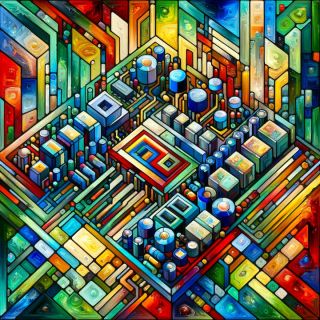KEY POINTS-
- The convergence of human creativity and AI curation is redefining the landscape of art and technology.
- AI's role in art creation blurs lines, expanding access while overwhelming traditional curation methods.
- Curators now mediate between AI's data-driven insights and the human emotional experience in art.
- AI's potential to exceed human capabilities in creativity and curation may redefine art itself.

Type in the prompt and push a button. Then, feel the sense of anticipation as your idea is technologically gestated.
In an era where technology and creativity intertwine and manifest with the push of a button, we find ourselves at a pivotal crossroads: the intersection of human creativity and the meticulous curation capabilities of artificial intelligence. This confluence presents a paradox where the boundless expanse of human ingenuity meets the precision of AI's analytical prowess. The question at the forefront of this collision is profound yet straightforward: how do we navigate this complex tapestry of technology-driven creativity without losing the essence of human touch?
The Overwhelming Tide of Technological Creativity
The digital age has ushered in a tsunami of creative output. From AI-generated paintings echoing the strokes of Van Gogh to algorithms composing symphonies in the style of Bach, the line between human and machine-made art is increasingly blurred. This proliferation of creative content, fueled by advancements in technology, presents a dual-edged sword. On one hand, it democratizes art, enabling more voices to contribute to the cultural milieu. On the other, it inundates us with a deluge of content, challenging our capacity to discern quality and authenticity.
The Shifting Role of Curation
Traditionally, curation has been the realm of human experts—gallery owners, editors, and cultural critics—who wielded the authority to determine what constitutes art and quality. However, as the volume of creative content explodes, these gatekeepers are overwhelmed, necessitating a shift towards a more inclusive and multifaceted approach to curation. Enter the age of AI, where algorithms can analyze vast amounts of data, identifying patterns and trends that may elude human curators.
Human vs. AI Curation: A Delicate Balance
The integration of AI in the curation process raises poignant questions about the essence of creativity and the role of human judgment. Can an algorithm truly understand the nuances of emotional resonance that a piece of art invokes in a human observer? While AI can sort, classify, and even predict preferences, it lacks the subjective, often inexplicable human experience of art. This dichotomy presents a unique challenge: balancing the efficiency and breadth of AI curation with the depth and intuition of human insight.
The Curator as an Intermediary
In this new landscape, the role of the curator evolves. Rather than being mere selectors, curators become interpreters and bridge-builders, translating the language of AI analytics into meaningful human experiences. They are tasked with integrating the quantitative insights of AI with the qualitative nuances of human perception. This role is especially crucial in artistic fields, where the emotional and experiential aspects of art cannot be fully captured by algorithms.
AI-Enhanced Creativity and Curation: A New Frontier
The prospect that AI might not only match but potentially surpass human capabilities in both creativity and curation is a provocative and transformative idea. When we consider the realms of creativity and curation, we typically attribute superior prowess to the human mind with its intrinsic understanding of emotional depth, cultural nuances, and historical context. However, AI's rapid advancement paints a different picture. With its ability to process and analyze vast datasets far beyond human capacity, AI can uncover patterns, inspirations, and connections that might escape even the most learned human curator or the most creative artist. In terms of creativity, AI can synthesize and recombine elements from a vast array of styles, periods, and mediums, potentially leading to groundbreaking new forms of art that challenge our conventional understanding of creativity. In curation, AI's objectivity and expansive analysis could offer a more democratized and inclusive approach, unshackling art from the subjective preferences and potential biases of human gatekeepers.
This shift could redefine art and curation, making them more reflective of a collective, multifaceted human experience rather than a singular, subjective perspective. Such a scenario, where AI excels in both creativity and curation, invites us to reconsider the very essence of art and its role in society, heralding a future where AI-generated art and curation are not just accepted but revered for their unique contributions to the cultural landscape.
Embracing the Future with Mindful Curation
The future of creativity and curation in the age of AI is not a dystopian landscape where human creativity is rendered obsolete. Instead, it is a dynamic, collaborative space where human and artificial intelligence coexist, complement, and enhance each other. The challenge and opportunity lie in harnessing the best of both worlds: the emotive depth of human creativity and the analytical prowess of AI. By doing so, we can navigate this new era not with apprehension, but with the excitement and anticipation of the boundless possibilities that this confluence of human and machine creativity holds.
Go ahead, push that button and see what you create...


